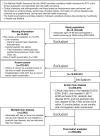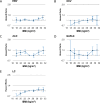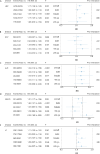Impact of high body mass index on hepatocellular carcinoma risk in chronic liver disease: A population-based prospective cohort study
- PMID: 39841714
- PMCID: PMC11753674
- DOI: 10.1371/journal.pone.0316175
Impact of high body mass index on hepatocellular carcinoma risk in chronic liver disease: A population-based prospective cohort study
Abstract
Background and aims: We investigated associations between body mass index (BMI) and hepatocellular carcinoma (HCC) in patients with hepatitis B (HBV) C (HCV) virus infection, alcoholic liver disease (ALD), non-alcoholic fatty liver disease (NAFLD), and liver cirrhosis (LC).
Methods: We followed 350,608 Korean patients with liver disease who underwent routine health examinations from 2003-2006 until December 2018 via national hospital discharge records. Multivariable adjusted hazard ratios (HRs) per 5-kg/m2 BMI increase (BMI ≥25 kg/m2) for HCC risk were calculated using Cox models. HCC developed in 17,752 patients.
Results: The HRs (95% CI) were 1.17 (1.06-1.28), 1.08 (0.87-1.34), 1.34 (1.14-1.58), 1.51 (1.17-1.94), and 1.11 (1.00-1.23) for HBV, HCV, ALD, NAFLD, and LC, respectively. The HRs for HBV were 1.45 (1.23-1.70) and 1.06 (0.95-1.19) in women and men, respectively; the corresponding HRs for LC were 1.27 (1.07-1.50) and 1.02 (0.90-1.16), respectively. In patients <65 years old with HBV, HCV, and NAFLD, the HRs were 1.17 (1.07-1.29), 1.33 (1.03-1.73), and 1.20 (0.87-1.64), respectively; the corresponding HRs were 1.05 (0.70-1.59), 0.74 (0.50-1.10), and 2.40 (1.62-3.54), respectively, in patients ≥65 years old. A BMI of 27.5-29.9 kg/m2 showed significantly higher HCC risks in patients with HBV, ALD, NAFLD, and LC.
Conclusions: Higher BMIs were associated with increased HCC risks in patients with HBV, ALD, NAFLD, and LC. Overweight status increased HCC risk. Women with HBV and LC had stronger BMI-HCC associations than men. The effect of high BMI was stronger in older patients with NAFLD and younger patients with viral hepatitis.
Copyright: © 2025 Kim et al. This is an open access article distributed under the terms of the Creative Commons Attribution License, which permits unrestricted use, distribution, and reproduction in any medium, provided the original author and source are credited.
Conflict of interest statement
The authors have declared that no competing interests exist.
Figures



Similar articles
-
Hepatocellular Carcinoma Etiology Drives Survival Outcomes: A Population-Based Analysis.Cancer Epidemiol Biomarkers Prev. 2024 Dec 2;33(12):1717-1726. doi: 10.1158/1055-9965.EPI-24-0626. Cancer Epidemiol Biomarkers Prev. 2024. PMID: 39240221 Free PMC article.
-
Non-alcoholic fatty liver disease is associated with greater risk of 30-day hospital readmission in the United States (U.S.).Ann Hepatol. 2023 Jul-Aug;28(4):101108. doi: 10.1016/j.aohep.2023.101108. Epub 2023 Apr 23. Ann Hepatol. 2023. PMID: 37088421
-
Clinical Patterns and Outcome of Hepatocellular Carcinoma in Patients with Nonalcoholic Fatty Liver Disease.Can J Gastroenterol Hepatol. 2020 Jun 3;2020:4873875. doi: 10.1155/2020/4873875. eCollection 2020. Can J Gastroenterol Hepatol. 2020. PMID: 32566546 Free PMC article.
-
Changes in the Global Burden of Chronic Liver Diseases From 2012 to 2017: The Growing Impact of NAFLD.Hepatology. 2020 Nov;72(5):1605-1616. doi: 10.1002/hep.31173. Epub 2020 Oct 27. Hepatology. 2020. PMID: 32043613
-
[Alcoholic liver diseases in Japan and modification by hepatitis virus].Nihon Arukoru Yakubutsu Igakkai Zasshi. 2003 Oct;38(5):403-14. Nihon Arukoru Yakubutsu Igakkai Zasshi. 2003. PMID: 14639919 Review. Japanese.
References
MeSH terms
LinkOut - more resources
Full Text Sources
Medical

